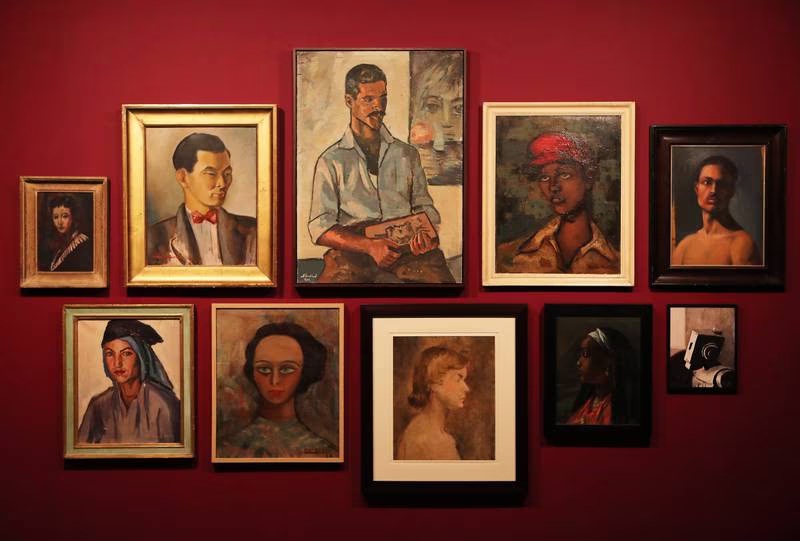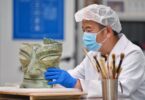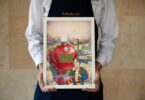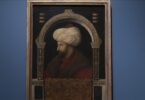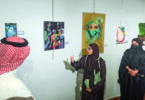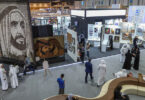Razmig Bedirian
When the time came for the Barjeel Art Foundation to move back to the second floor of the Sharjah Art Museum – after being cleared in November for last year’s biennial – the institution had originally intended to return with an exhibition highlighting contemporary artworks from the Arab world.
The show would have been a marked departure for the foundation. Between landmark exhibitions in London, New York, Berlin and those in Sharjah, the Barjeel Art Foundation has developed an idiosyncratic reputation for its focus on modern art from the region, perhaps less so for its contemporary pieces.
The show they initially had in mind would have highlighted the artworks in their collection that have been produced in the last 50 years. However, art educators and scholars living in the UAE urged the foundation to reconsider. Its focus on modern art, they said, was a unique offering in the local community, one with indispensable pedagogical value.
“That’s why we switched it,” founder Sultan Al Qassemi tells The National. “We first said let’s show contemporary art, which we have been buying heavily in the last few years. But at the urging of two scholars, who both said they bring their students to see the modern works by artists we usually show, we ended up making it again 80-90 per cent modern.”
Parallel Histories, which runs until spring 2024, presents more than 120 works by Arab artists, 78 of which have never been shown in Sharjah before.
:quality(70)/cloudfront-eu-central-1.images.arcpublishing.com/thenational/L5GP4ADQKFHSZMCP666M7YOSPU.jpg)
Several staple artworks that have appeared locally are present. These include Inji Efflatoun’s Dreams of the Detainee, a painting that evokes the bleak setting of her incarceration by Gamal Abdel Nasser’s government, under a decree that sanctioned the detainment of women involved in political activism.
Dia Al Azzawi’s Al-Jawf Masks, meanwhile, is a fevered example of the approach that has made the Iraqi painter a pillar of Arab modernism, with prickly shapes, handprints and faces emerging from the canvas’s shadowy chasm.
Le Gardien de la Vie by Hamed Ewais on the other hand is an artful depiction of the Arab world rising from the debilitating 1967 war with Israel, starring the colossal figure of a soldier looming to protect an Egypt going about its daily life.
Kadhim Hayder’s Fatigued Ten Horses Converse with Nothing, featuring an abstraction of white horses huddled in grief, is drawn from the seventh-century Battle of Karbala; whereas Safia Farhat’s 1963 work The Bride celebrates North African heritage in textile.
Each of these works, along with others that had been previously shown, have historical and artistic merit that are pivotal examples of the trajectory of Arab modernism.
:quality(70)/cloudfront-eu-central-1.images.arcpublishing.com/thenational/6N5CXC4MFJCVXFNNEJ65XJBAK4.jpg)
Where Parallel Histories truly shines, however, is in its introduction of modern artists who have not yet been given their due attention, in a way enhancing its educational component. As has been its mission for the past few years, the foundation wanted to ensure a gender-balanced exhibition. Nearly 70 works, or 56 per cent of the exhibition, are by women. Some, despite having produced works on par in both style and substance to their more celebrated contemporaries, have long been overlooked.
One of the most captivating pieces is Lotus Girl by Nazek Hamdy, a painting of an Indian woman created by the Egyptian artist in 1955. The work is testament to Hamdy’s time as a student in India, featuring Bengal murals, and perhaps more strikingly, a lotus flower – a symbol that is significant in both Indian and Egyptian cultures.
“[Hamdy] has had such an important career, but for whatever reason, she hasn’t received the spotlight,” curator Suheyla Takesh says. “The lotus flower is a shared national symbol for India and Egypt. And we do think it’s important that when people from different cultures come they can see themselves. It’s really important they recognise that they are part of this conversation, that the works represent them.”
:quality(70)/cloudfront-eu-central-1.images.arcpublishing.com/thenational/VUETPCRUPVFFJFO7S3XRH7YMKE.jpg)
Two works by Palestinian artist Zulfa Al Saadi are also new highlights. These include Man with Goat, painted in the 1940s, and Pharaoh’s Hat (Tomb of Absalom), created around the same time.
“Al Saadi challenges the notion that women were not exhibiting [at the time],” Al Qassemi says. “She had a solo exhibition 90 years ago, in 1933 in Jerusalem.
The paintings elegantly accompany Lyddia Ata’s Tower of the Church of Nativity, circa 1930s, which is a rarity.
“It’s the only place in the Arab world where many of these artists are on display right now,” Al Qassemi says. “Lyddia Ata’s work is so rare that almost [only] 30 works exist in total. We struggled to get her date of birth, where and when she died.”
Another surprising find is a 1979 painting of Dubai’s creek by Hala Al-Kouatli, daughter of Shukri al-Quwatli, the first president of post-independence Syria. The work depicts the tip of a dhow and people going about their daily business along the banks. Despite being painted more than four decades ago and the many changes that transformed the landscape, the scene looks merrily familiar and documents the bustle that was pivotal to the emirate’s economy.
While the pieces by celebrated artists are as enthralling as ever, the artworks by these rediscovered talents pave the way for a more multifaceted examination of Arab modernism.
“Many of these artists, especially the women, existed in parallel with different groups, genders, different ethnicities and religions,” Al Qassemi says. “Many of them didn’t overlap. Many of them just happened to create works at the same time with other artists.”
Despite this apparent isolation from one another, there are notable similarities between works, whether in terms of aesthetic approach or their references. It is from here that the exhibition’s title, Parallel Histories, stems from. The name also takes inspiration from the painting by Syrian artist Mouteea Murad, which features slim, variegated parallel lines that broaden towards the centre on a white backdrop.
“We began to notice that a lot of themes, subject matter, and materiality were carried through from the mid-20th century with the boom of modernism until today,” Takesh says. “You had, of course, works done on Palestine, a very pertinent subject right now that was already happening in the 1950s and 60s. These are not just works from Palestine but about the Palestinian predicament that artists from the region were responding to, and it’s still carrying over.”
These reflecting themes are underscored with the exhibition’s thoughtful curation.
Raafat Ballan’s 2021 painting The City Before it was Transformed, for instance, which shows a group of people across two tables, drinking tea and conversing merrily, is a tribute to a Gaza before besiegement by Israel. The painting takes cues from a photograph by Kegham Djeghalian, who founded Gaza’s first photography studio in 1944. The painting resonates with the themes present in accompanying pieces, such as Palestinian artist Abdul Hay Mosallam Zarara’s untitled 1987 ceramic artwork, which employs fantastical figures in its tribute to Palestinian culture; Saudi artist Abdulhalim Radwi’s Palestine, a 1962 work dedicated to the resilience of the country’s people; and Emirati artist Abdul Qader Al Rais’s Waiting, a 1970 canvas that evokes the melancholy and struggle of Palestinian children.
:quality(70)/cloudfront-eu-central-1.images.arcpublishing.com/thenational/2LC5V5M5XBE6JCLWTA2OY2UHMI.jpg)
The latter painting has been exhibited by the foundation in Sharjah before, but even with artworks that had been previously presented in the emirate, there are novel undertones and facets that are highlighted through the exhibition’s curation.
This is particularly prevalent with how sculptural works are installed. The geometric features of Ibrahim El-Salahi’s 1964 The Last Sound, for instance, are enlivened with its placement behind Armen Agop’s untitled bronze piece from 2008.
:quality(70)/cloudfront-eu-central-1.images.arcpublishing.com/thenational/IIOLSELU6ZAIZASRGQU7VMSOPY.jpeg)
Abdel Badie Abdel Hay’s Mobaghata, a 1972 sculpture of basalt stone that depicts a cat on top of a snake, and which can evoke intimacy or viciousness depending on the viewer’s angle, resonates with Margo Veillon’s abstractions in Stork Birds and Salah Abdel Kerim’s 1964 cubist painting of a cat, Cesar. Saudi artistSamer Tabbaa’s Untitled 7, a 2007 graphite on wood sculpture, stands vertically in the centre of a space decked with works dominated by parallel lines, including Driss Ouadahi’s Cordoba and Granada painting from 2022 and Afra Al Dhaheri’s I met a line and we made paintings, created in the same year.
These echoing forms and themes make Parallel Lines a particularly electrifying experience. As the labels to the artworks are printed on the side as opposed to beside each piece, there are no visual disruptions as you navigate the works, allowing for their contents to counterpoint and harmonise with each other in a way that wouldn’t have been possible otherwise.
“It gives you the opportunity to explore the work without interruptions, both visually and intellectually,” Takesh says. “You are orbiting the work without necessarily having any context, any name, country or year. To interpret it in your own way.”
Courtesy: thenationalnews

